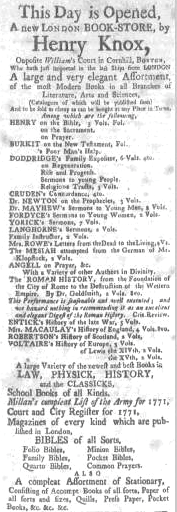Henry Knox
Henry Knox (July 25, 1750 – October 25, 1806) was a military officer of the Continental Army and later the United States Army, who also served as the first United States Secretary of War from 1789 to 1794. Knox is best known for his role in the American Revolutionary War, where he established the artillery branch of the American military and executed the remarkable feat of transporting heavy artillery over 300 miles in the winter to fortify Dorchester Heights, leading to the British evacuation of Boston.
Early Life[edit | edit source]
Henry Knox was born in Boston, Massachusetts, to parents of Scottish and Irish descent. His father was a shipbuilder who died when Knox was just nine years old, leaving the family in financial distress. Knox received a basic education before he was forced to leave school and work to support his family. Despite his early departure from formal education, Knox was an avid reader, with a particular interest in military history and science.
Military Career[edit | edit source]
Knox's military career began with his involvement in a local militia, a common practice among American colonists. His expertise in artillery was self-taught, derived from his extensive reading. When the American Revolutionary War broke out in 1775, Knox joined the Continental Army, quickly distinguishing himself as a talented artillery officer.
One of his most notable achievements came during the winter of 1775-1776 when Knox led the expedition to transport captured British artillery from Fort Ticonderoga to Boston. This arduous journey, known as the "Noble Train of Artillery," involved moving 60 tons of cannons and other armaments across difficult terrain, including frozen rivers and mountains, in the dead of winter. The successful arrival of these cannons allowed the Continental Army to fortify Dorchester Heights, which played a crucial role in the British decision to evacuate Boston in March 1776.
Following this success, Knox served in several key battles throughout the war, including the Battle of Long Island, the Battle of Trenton, and the Battle of Yorktown. His leadership and expertise in artillery were instrumental in the Continental Army's successes.
Post-War Career[edit | edit source]
After the war, Knox became a key figure in the early United States government. He was appointed the first Secretary of War by President George Washington in 1789, a position he held until 1794. In this role, Knox was responsible for the development of the first American naval fleet, the establishment of federal armories and arsenals, and the negotiation of treaties with Native American tribes.
Legacy[edit | edit source]
Henry Knox's contributions to the American Revolutionary War and the early United States were significant. He is remembered for his strategic use of artillery, which played a pivotal role in several key battles. His efforts in transporting the cannons to Boston are particularly celebrated for their ingenuity and impact on the outcome of the war.
Knox's legacy also includes his influence on the development of the United States military. As Secretary of War, he laid the groundwork for the professionalization of the American military forces and the establishment of a national defense infrastructure.
Death[edit | edit source]
Henry Knox died on October 25, 1806, at the age of 56. He is buried in Thomaston, Maine, a town that was part of the land grant he received for his service in the war.
This American Revolutionary War related article is a stub. You can help WikiMD by expanding it.
Search WikiMD
Ad.Tired of being Overweight? Try W8MD's physician weight loss program.
Semaglutide (Ozempic / Wegovy and Tirzepatide (Mounjaro / Zepbound) available.
Advertise on WikiMD
|
WikiMD's Wellness Encyclopedia |
| Let Food Be Thy Medicine Medicine Thy Food - Hippocrates |
Translate this page: - East Asian
中文,
日本,
한국어,
South Asian
हिन्दी,
தமிழ்,
తెలుగు,
Urdu,
ಕನ್ನಡ,
Southeast Asian
Indonesian,
Vietnamese,
Thai,
မြန်မာဘာသာ,
বাংলা
European
español,
Deutsch,
français,
Greek,
português do Brasil,
polski,
română,
русский,
Nederlands,
norsk,
svenska,
suomi,
Italian
Middle Eastern & African
عربى,
Turkish,
Persian,
Hebrew,
Afrikaans,
isiZulu,
Kiswahili,
Other
Bulgarian,
Hungarian,
Czech,
Swedish,
മലയാളം,
मराठी,
ਪੰਜਾਬੀ,
ગુજરાતી,
Portuguese,
Ukrainian
Medical Disclaimer: WikiMD is not a substitute for professional medical advice. The information on WikiMD is provided as an information resource only, may be incorrect, outdated or misleading, and is not to be used or relied on for any diagnostic or treatment purposes. Please consult your health care provider before making any healthcare decisions or for guidance about a specific medical condition. WikiMD expressly disclaims responsibility, and shall have no liability, for any damages, loss, injury, or liability whatsoever suffered as a result of your reliance on the information contained in this site. By visiting this site you agree to the foregoing terms and conditions, which may from time to time be changed or supplemented by WikiMD. If you do not agree to the foregoing terms and conditions, you should not enter or use this site. See full disclaimer.
Credits:Most images are courtesy of Wikimedia commons, and templates, categories Wikipedia, licensed under CC BY SA or similar.
Contributors: Prab R. Tumpati, MD




